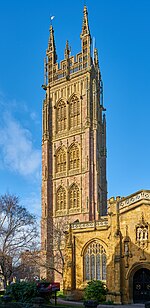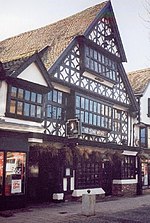Gray's Almshouses
1635 establishments in EnglandAlmshouses in SomersetBuildings and structures completed in 1635Buildings and structures in TauntonGrade I listed almshouses ... and 2 more
Grade I listed buildings in Taunton DeaneHistory of Taunton

Gray's Almshouses is a terrace of almshouses in Taunton, Somerset, England, founded in 1635 by the wealthy cloth-merchant Robert Gray, whose monument survives in the Church of St Mary Magdalene. The building is one of the oldest surviving in Taunton and is one of the earliest brick buildings in the county. The Almshouses were designed to provide accommodation for six men and ten women and for a reader who was to act as chaplain and schoolmaster. It is a Grade I listed building as designated by English Heritage. Following renovation in the late twentieth century it now comprises sheltered accommodation of nine flats for the elderly.
Excerpt from the Wikipedia article Gray's Almshouses (License: CC BY-SA 3.0, Authors, Images).Gray's Almshouses
East Street,
Geographical coordinates (GPS) Address Nearby Places Show on map
Geographical coordinates (GPS)
| Latitude | Longitude |
|---|---|
| N 51.01475 ° | E -3.09801 ° |
Address
East Street
East Street
TA1 3NB , Firepool
England, United Kingdom
Open on Google Maps











